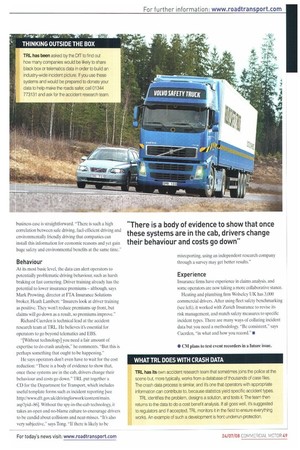Crash course
Page 48

Page 49

If you've noticed an error in this article please click here to report it so we can fix it.
Gathering data about collisions and near misses can improve your company's productivity, lower costs and save lives. Here's how.
Words: Louise Cote Most road transport operators are acutely aware of their 0-licence undertakings, as well as their duty of care under health and safety legislation. But there are many ways of collating information about driver behaviour, near misses and collisions which can prove useful tools in targeting driver training, accident prevention and even provide a defence in court.
There is a wealth of technology available to record vehicle event data, and many firms already use this. Telematics systems are widely used in commercial fleets, although most are used for vehicle tracking and few users are exploiting the enormous potential of these systems.
In the US, black-box technology is being built into cars. Event data recorders track a vehicle's components. including the transmission, indicators, brakes and speed.
In the event of a collision usually triggered by a specific G-force the box will save the last 30 seconds of data, giving authorities, owners and drivers a log to help them reconstruct the final moments before an incident.
This black-box technology in itself is not dissimilar to that once proposed for road pricing: only the application differs. Across the pond, the technology is frequently used for litigation, where either the prosecution or defence can cite the data to prove their case in court.
Evaluation
In the UK, the Transport Research Laboratory (TRL) is working with commercial fleets that have installed the technology to evaluate its effectiveness in collecting crash data, using this to prevent future collisions.
"We are working for one insurance company in particular which has paid for the system to be installed in a customer's fleet to evaluate its effectiveness in claims reduction," says research scientist Simon Tong.
Tong believes few firms are exploiting the full potential of such systems or the data to which they provide access.
-Telematics are a way of collecting and downloading data," he explains. -Firms have installed these systems for specific reasons, but have no idea what to do with the wealth of other information the system can collect."
TRL is currently working with one telematics provider to widen the scope of its data collection. Tong feels the business case is straightforward. "There is such a high correlation between safe driving, fuel-efficient driving and environmentally friendly driving that companies can install this information for economic reasons and yet gain huge safety and environmental benefits at the same time.
Behaviour
At its most basic level, the data can alert operators to potentially problematic driving behaviour, such as harsh braking or fast cornering. Driver training already has the potential to lower insurance premiums — although. says Mark Prowting, director at ETA Insurance Solutions broker, Heath Lambert: "Insurers look at driver training as positive. They won't reduce premiums up front, but claims will go down as a result, so premiums improve."
Richard Cuerden is technical lead at the accident research team at TRL, He believes it's essential for operators to go beyond telematics and EBS.
"[Without technology] you need a fair amount of expertise to do crash analysis," he comments. "But this is perhaps something that ought to be happening."
He says operators don't even have to wait for the cost reduction: "There is a body of evidence to show that, once these systems are in the cab, drivers change their behaviour and costs go down." TRI., put together a CD for the Department for Transport, which includes useful template forms such as incident reporting [see http://www.dft.gov.uk/drivingforwork/contentimain. asp?pid=86]. Without the spy-in-the-cab technology, it takes an open and no-blame culture to encourage drivers to be candid about collisions and near-misses. "It's also very subjective," says Tong. "If there is likely to be misreporting, using an independent research company through a survey may get better results."
Experience
Insurance firms have experience in claims analysis, and some operators are now taking a more collaborative stance.
Heating and plumbing firm Wolseley UK has 3,000 commercial drivers, After using fleet safety benchmarking (see left), it worked with Zurich Insurance to revise its risk management, and match safety measures to specific incident types. There are many ways of collating incident data but you need a methodology. "Be consistent," says Cuerden, -in what and how you record," •
• CM plans to test event recorders in a future issue.




























































































































































